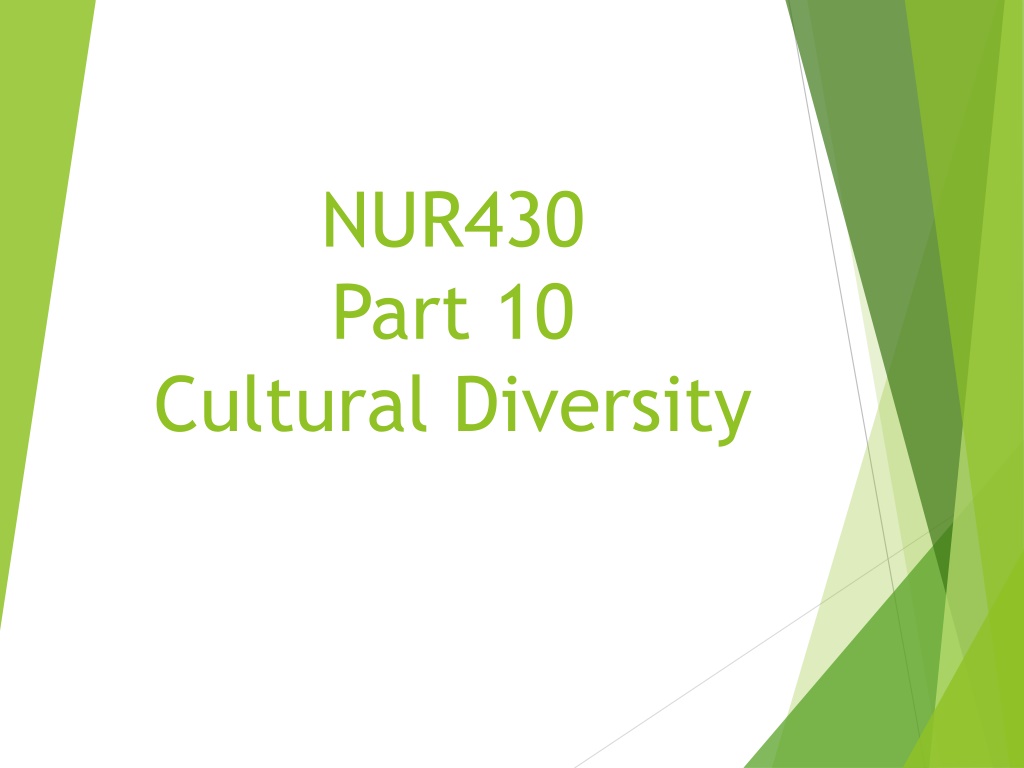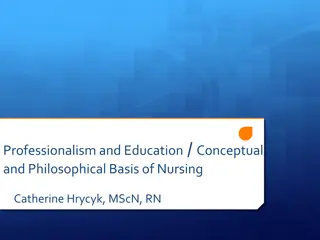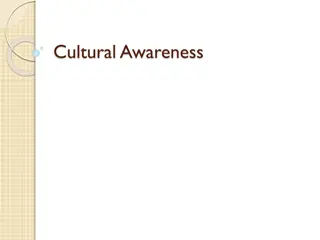Understanding Cultural Diversity in Nursing Education
Explore essential concepts in transcultural nursing, including Leininger's Transcultural Nursing Theory and other models. Learn about cross-cultural nursing, cultural competence, diversity in nursing practice, and key terms like cultural imposition and acculturation. Enhance your cultural competence in nursing through awareness, knowledge, and respect for diverse populations.
Download Presentation

Please find below an Image/Link to download the presentation.
The content on the website is provided AS IS for your information and personal use only. It may not be sold, licensed, or shared on other websites without obtaining consent from the author. Download presentation by click this link. If you encounter any issues during the download, it is possible that the publisher has removed the file from their server.
E N D
Presentation Transcript
NUR430 Part 10 Cultural Diversity
Learning Objectives After lecture-discussion, students are expected to: Explain the various concepts in transcultural nursing Discuss the important elements of Leininger sTranscultural Nursing Theory, Campinha- Bacote s Culturally Competent Model of Care, Geiger and Davidhizer s Model and Purnell s Model
Basic Concepts Transcultural Nursing the study of the lifeways and patterns of persons of various cultures including their healthcare practices and nursing s role in that culture. Cross Cultural Nursing the study of the lifeways and patterns of persons of various cultures from an anthropological perspective that is being applied to nursing.
Concepts (Contd) International Nursing the exchange of nurses between 2 or more nations/cultures. Culture the patterns and lifeways that guide a group of people s worldview and decision-making. Cultural Imposition a situation where one culture forces their values and beliefs on another culture or subculture.
Basic Concepts Diversity Divertere in Latin Being different or having differences Diversity in nursing practice Providing competent care to clients from different cultures, conducting research in multi-cultural settings, and implementing educational programs to diverse population 5
Concepts (Contd) Acculturation the process of adapting or modifying the patterns and lifeways of an adopted culture as a result of contact with another group or individual. Assimilation the process of accepting some of the cultural practices or traits of the prevailing culture into one s own daily activities. Refugee a person who flees from persecution, invasion, or political danger.
Concepts (Contd) Generalization usually an oversimplification made about behaviors of an individual or large group. Stereotyping to make a person possess or believe to possess characteristics or qualities that typify a particular group.
Cultural Competence in Nursing Developing an awareness of one s own existence, sensations, thoughts, and environment without letting it have an undue influence on those from other backgrounds. Demonstrating knowledge and understanding of the client s culture. Accepting and respecting cultural differences. Adapting care to be congruent with the client s culture.
4 Levels of Cultural Competence Unconscious incompetence not being aware that one is lacking knowledge about another culture. Conscious incompetence being aware that one is lacking knowledge about another culture. Conscious competence learning about the client s culture, verifying generalizations about the client s culture, and providing culturally specific interventions. Unconscious competence automatically providing culturally congruent care to clients of a diverse culture.
Nursing Theorists in Transcultural Nursing Madeleine Leininger the founder of Transcultural Nursing. Dr. Leininger studied anthropology in the 1950 s and early 60 s. She earned her PhD in Cultural Anthropology. She then decided that nursing was constantly dealing with the lifeways and patterns of peoples of many backgrounds and that in caring for these persons, nurses needed to be sensitive to the unique needs of all peoples. She felt strongly that we should NOT impose our views on others whenever possible.
Contributions of Madeleine Leininger (July 13, 1925-August 10, 2012) to the Development of Transcultural Nursing from the TCNS website: www.tcns.org Contribution Leininger noticed and studied the cultural differences in the perception of care Leininger earned a doctorate in cultural anthropology [Univ. of Washington] Leininger offered first courses and telelectures offered in Transcultural Nursing [Univ. of Colorado School of Nsg] Est. 1st PhD nurse-scientist program combining anthro- pology and nursing[Univ. of Colorado School of Nsg] !st Academic Dept. in Transcultural Nursing est d [Univ. of Washington, School of Nsg] Transcultural Nursing Society(TNS) est d as the official organization of transcultural nursing. First advanced degree programs [Master s & Doctoral] est d [Univ. of Utah School of Nursing] Date 1954 1965 1965- 1969 1973 1974 1978
Transcultural Nursing Society(TNS)initiated certification examinations: Certified Transcultural Nurse Journal of Transcultural Nursing (JTN) 1st published as official publication of the TNS; Leininger is founding editor. The goal of the JTN is to disseminate transcultural ideas, theories, research findings, and/or practice experiences. 1988 1989 Dr. Leininger published Culture Care Diversity and Universality: A theory of Nursing in which she outlines her theory [Culture Care Diversity and Universality and the Sunrise Model] and its research implications. 1991 Dr. Leininger published Transcultural Nursing Concepts, Theories, Research & Practices as a text for undergraduate and graduate nursing students. 1995 Dr. Leininger continued to teach a graduate level Transcultural Course at the Univ. of Northern Colorado. She guest lectured internationally at age 77!! 2001+
Transcultural Nursing- Leininger, 1997 Definition- A formal area of study and practice focused on comparative holistic culture care, health and illness patters of people with respect to differences and similarities in their cultural values, beliefs, and lifeways with the goal to provide culturally congruent, competent and compassionate care 14
Cultural needs Equal access to treatment and care Respect for cultural beliefs and practices Leininger, (1995) & Narayanasamy, (2003) Religious beliefs, taboos, customs Dietary, personal care needs, daily routines Dying needs Communication needs Cultural safety needs, 15
Equal access to treatment and care Ethnicity racial discrimination, racial harassment and oppression Secondary problems stress psychological trauma 16
Communication needs Barrier Impede early detection delay prompt treatment and care Forms Language Non-verbal communication Translation services Interpreters Family interpreters Health condition acute illness & crisis 17
Transcultural Care Practice Initiative Enthusiasm Commitment of individuals and groups Strategic planning Organization & coordination of services Funding Education Recruitment & research 18
Leiningers Theory (contd) Professional Systems are different depending upon the Health Care Delivery System of that culture. Whether there is socialized medicine, private insurance, communal healthcare, poor economic support vs. great wealth, all contribute to the influence of the utilization of Professionals to prevent illness, heal illness, and promote health and wellness. Nursing must collaborate within the healthcare delivery system to plan and implement safe, effective, culturally competent care.
How to Provide Culturally Congruent Care: Leininger suggests 3 approaches to plan and implement Culturally Congruent Care. The first is Cultural Care Preservation/Maintenance where we look at what we as nurses can do to preserve and maintain the cultural practices of an individual or family while receiving safe, holistic care somewhere in the Healthcare Delivery System.
How to Provide Culturally Congruent Care: (cont d) The second approach is Cultural Care Accommodation/Negotiation where we look at what we as nurses can do to accommodate the patient and negotiate with the patient within the healthcare environment in order to provide culturally congruent care while he/she is in the Healthcare Delivery System.
How to Provide Culturally Congruent Care: (Cont d) The third approach is Cultural Care Repatterning/Restructuring where we look at what we as nurses need to do with the patient and family to repattern or restructure their lifeways in order to promote healing and wellness, always being cognizant of the cultural influences that affect why they do what they do in their life experience.
HEALTH PRACTICES IN DIFFERENT CULTURES Use of Protective Objects Protective objects can be worn or carried or hung in the home- charms worn on a string or chain around the neck, wrist, or waist to protect the wearer from the evil eye or evil spirits. Use of Substances It is believed that certain food substances can be ingested to prevent illness.
HEALTH PRACTICES IN DIFFERENT CULTURES Religious Practices Burning of candles, rituals of redemption etc. Traditional Remedies The use of folk or traditional medicine is seen among people from all walks of life and cultural ethnic back ground. Healers Within a given community, specific people are known to have the power to heal
HEALTH PRACTICES IN DIFFERENT CULTURES Immigration Immigrant groups have their own cultural attitudes ranging beliefs and practices regarding these areas. Gender Roles In many cultures, the male is dominant figure and often they take decisions related to health practices and treatment. In some other cultures females are dominant. In some cultures, women are discriminated in providing proper treatment for illness.
HEALTH PRACTICES IN DIFFERENT CULTURES Beliefs about mental health Mental illnesses are caused by a lack of harmony of emotions or by evil spirits. Problems in this life are most likely related to transgressions committed in a past life. Economic Factors Factors such as unemployment, underemployment, homelessness, lack of health insurance poverty prevent people from entering the health care system.
HEALTH PRACTICES IN DIFFERENT CULTURES Personal Space Respect the client's personal space when performing nursing procedures. The nurse should also welcome visiting members of the family and extended family.
ROLE OF NURSE Determine the client's cultural heritage and language skills. Determine if any of his health beliefs relate to the cause of the illness or to the problem. Collect information that any home remedies the person is taking to treat the symptoms
ROLE OF NURSE Nurses should evaluate their attitudes toward ethnic nursing care. Self-evaluation helps the nurse to become more comfortable when providing care to clients from diverse backgrounds Understand the influence of culture, race ðnicity on the development of social emotional relationship, child rearing practices & attitude toward health.
ROLE OF NURSE Collect information about the socioeconomic status of the family and its influence on their health promotion and wellness Identify the religious practices of the family and their influence on health promotion belief in families. Understanding of the general characteristics of the major ethnic groups, but always individualize care. The nursing diagnosis for clients should include potential problems in their interaction with the health care system and problems involving the effects of culture
ROLE OF NURSE The planning and implementation of nursing interventions should be adapted as much as possible to the client's cultural background. Evaluation should include the nurse's self-evaluation of attitudes and emotions toward providing nursing care to clients from diverse sociocultural backgrounds. Self-evaluation by the nurse is crucial as he or she increases skills for interaction.























